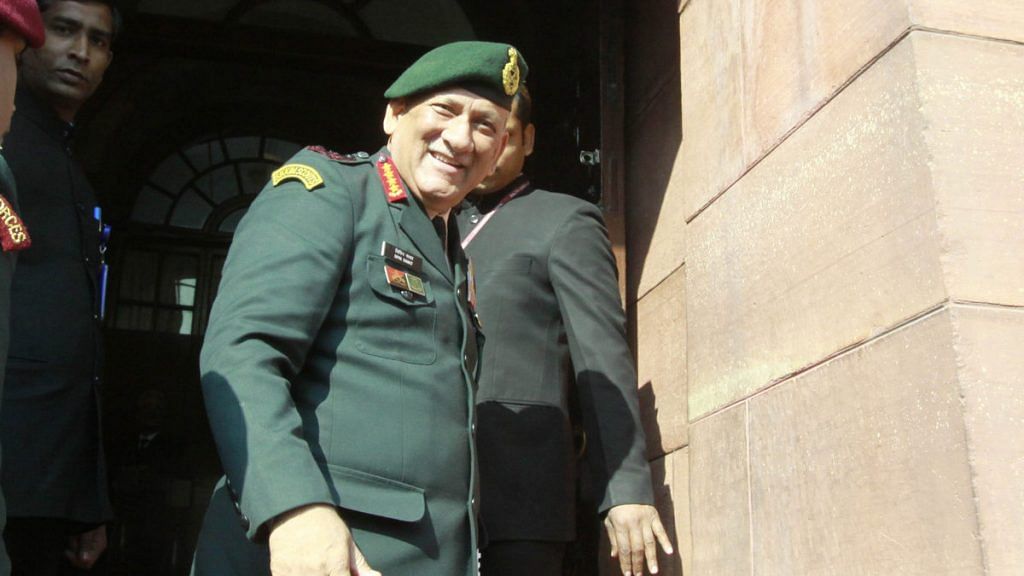Army chief General Bipin Rawat, who is the front-runner for the post of the Chief of Defence Staff, in a recent interview to ThePrint talked about a range of issues, from India’s operational strategy with respect to China to the role of the CDS and his plan to form Integrated Battle Groups.
My assessment of the fine print shows that there is a greater need to focus on transformation of the defence forces and not just look at mere cosmetic and incremental changes.
Role of CDS
General Bipin Rawat said that the Chief of Defence Staff (CDS) will have to be the “first among equals”. Whether he is a four or a five-star General is a non-issue, he said. “He will have to shed the inhibitions of that (his) service and convince the other two,” he said.
According to him, the CDS should integrate training and logistics for the three services. “Some of the operational doctrines would have to be integrated. And finally, we will have to come out with theatre commands,” the Army chief said.
I am afraid the General is focused on incremental and not transformational change. His own experience with the Chiefs of Staff Committee should have convinced him that ‘first among equals’ does not work in the military.
Based on the Group of Ministers’ report in 2001, the integration of training and logistics for the three services has been a ‘work in progress’ under the Chiefs of Staff Committee with little result on the ground. A ‘toothless CDS’ observing the niceties of ‘first among equals’ will meet the same fate. Even if the CDS is not a five-star General, there should be no doubt about the hierarchy of command.
Also read: Chief of Defence Staff bold step but Modi govt’s big challenge will be inter-service rivalry
Operational strategy against China
The Army chief said that there is a need to review our deployment along the Line of Actual Control (LAC) and not just replicate the LoC model. He instead called for technology-driven surveillance and reconnaissance, and building reserves for rapid response to cater for operational contingencies.
There can be no quarrel on this score. But what General Rawat has highlighted is a tactical issue, which can be corrected in-house. The northern front certainly requires a different strategy. Our border infrastructure is still inadequate when compared with China’s.
The qualitative and quantitative asymmetry in military technology is frightening. Our operational strategy is based on the traditional understanding of high-altitude warfare – occupy dominating heights and force the People’s Liberation Army (PLA) into engaging with our troops in close combat from a disadvantageous position.
On the other hand, the PLA, which adopted the Revolution in Military Affairs (RMA) two decades ago, is more likely to rely on high-end military technology to inflict a psychological defeat on the Indian forces. Borders of nuclear-armed nations do not or, I dare say, cannot change. However, a humiliating defeat can still be inflicted in selected sectors through the overwhelming use of aircraft, drone, missile and artillery-based precision-guided munitions (PGMs) and cyber-attacks to destroy deployed forces and infrastructure.
Therefore, it may be more prudent to go on the offensive on a wide front to secure territory and selectively engage the PLA in close combat to neutralise the advantage of PGMs.
Talking about a possible war scenario with China, General Rawat said the Chinese will focus “first on pulverising Indian command, control and logistics centres with missiles rather than fighting a full-fledged intense war in the initial stages”. If this is the modus operandi of the Chinese, then the General should focus on the larger issues of a radical review of our operational strategy against China and modernisation of our forces to seek parity with the neighbour.
Also read: Pakistan knows we’ll retaliate, they should remain in fear: Indian Army Chief Bipin Rawat
On Integrated Battle Groups
General Rawat spoke in detail about the creation of Integrated Battle Groups (IBGs) – more potent than a Brigade but more agile than a Division, which will be ready to go on the offensive in 24 hours. Two experimental IBGs will soon be in place in 9 Corps and 33 Corps.
IBGs will certainly be a part of General Rawat’s legacy, but this again is merely an incremental organisational change to better execute our pro-active operational strategy.
The transformational change requires a holistic review of our elephantine armed forces and archaic structures/organisations. It demands replacing forces with technology-driven resources.
The General’s legacy
General Bipin Rawat deserves to be complimented for the in-house reforms/changes he has pursued and executed during his tenure.
History has rarely given leaders a second chance to complete a mission they set out on. As a front-runner for the CDS, General Rawat may get that second chance with a tri-service charter in the next three months. With the Narendra Modi government keen to own and fund transformational changes in the Indian military, there cannot be a better opportunity.
Armed with an experience of nearly three years as the Army chief, the General must challenge and alter the status quo and bring about transformation through a revolution in Indian military affairs – RIMA – to fight the wars of the 21st century.
Also read: Air Marshal Nambiar, Kargil hero famous for jugaad in combat should have been IAF chief
Lt Gen H S Panag PVSM, AVSM (R) served in the Indian Army for 40 years. He was GOC in C Northern Command and Central Command. Post retirement, he was Member of Armed Forces Tribunal. Views are personal.
